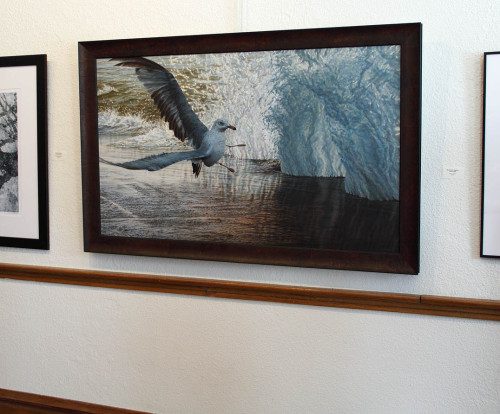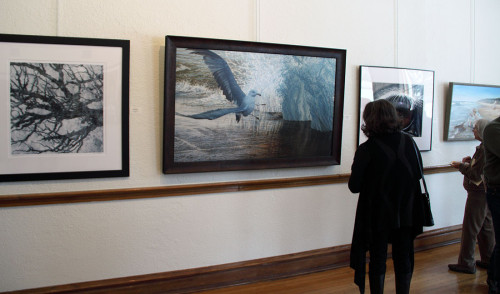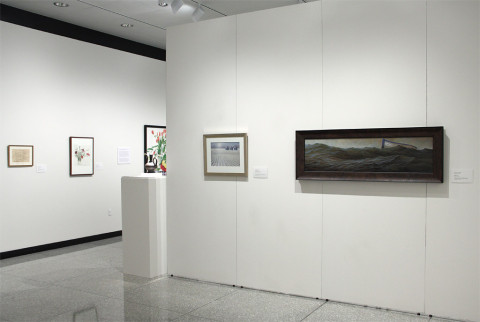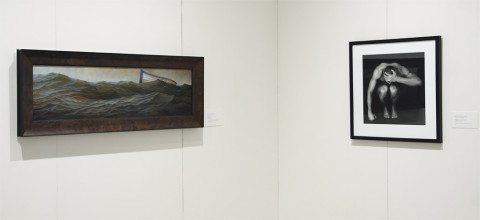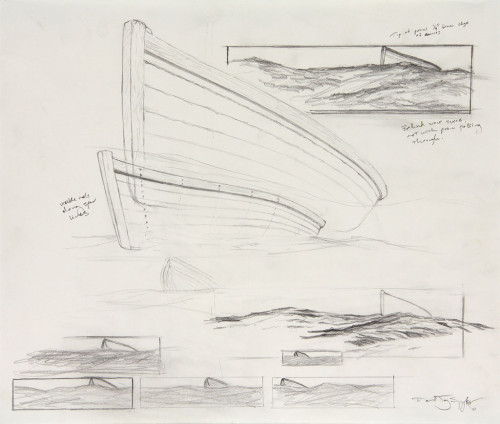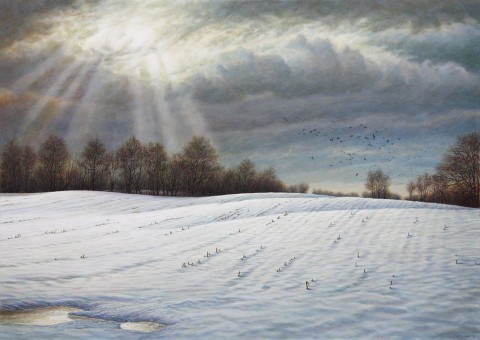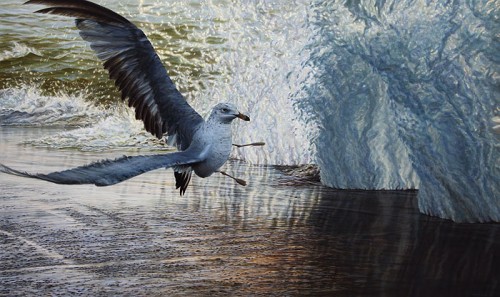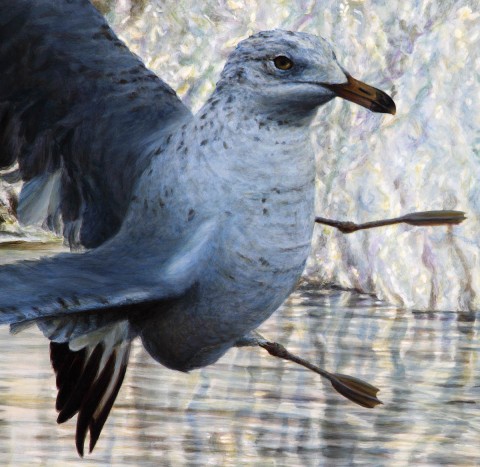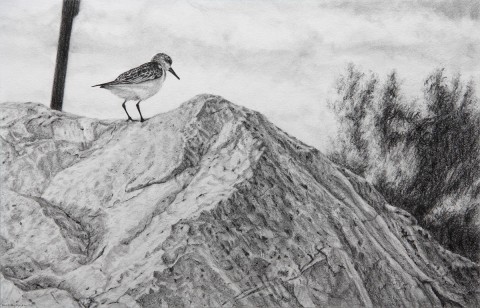Sudden Flight Awarded Best of Show
“Sudden Flight” was awarded Best of Show in the annual Regional Fine Arts Competition at the Carnegie Center for the Arts in Three Rivers, Michigan. Also on display are “Regatta” and “Winter Murder”.
The 2014 competition was judged by Greg Waskowsky, painter and Curator of Special Programs at the Kalamazoo Institute of Arts; Dave Curl, artist, photographer, and adjunct professor of Art at Kalamazoo College and professor emeritus as WMU; and Steve Curl, a sculptor who uses found objects and junk to create whimsical robots and abstract piece.
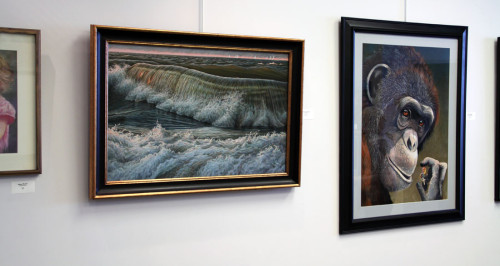
Regatta (on the left) at Carnegie Center for the Arts, Three Rivers, MI
Acyrlic on Canvas, 24 x 36 in., 2013
It’s a very nice show with a lot of great pieces by artists from eighteen counties in Michigan and Indiana – well worth the trip.
The exhibition runs through February 26, 2014.
Carnegie Center for the Arts
107 N Main St.
Three Rivers, MI 49093
269-273-8882
Martha Mayer Erlebacher, 1937–2013
Back in 1996, Martha chose one of my paintings, The Final Harvest, for the second place award at a competition in Michigan. This was the first award I ever received. I was very sad to hear of her death this past June. May she live on for a long time through her work, and may her presence be felt in those she touched throughout her life. Thank you, Martha.
http://youtu.be/65XxqL_i_2s
“Despite all the suffering and all the stress, I think how beautiful and aesthetic life can be.”
~ Martha Mayer Erlebacher
Artistic Motivations Exhibitions: Boats Exhibition Kalamazoo Institute of Arts Preliminary Study Water
by David Jay Spyker
leave a comment
“Cradle” Displayed in “Copley to Kentridge: What’s New in the Collection?”
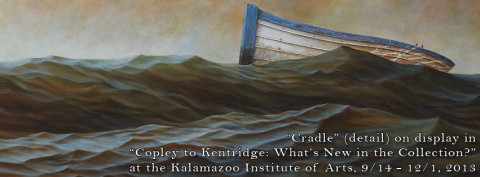 The painting, Cradle, joins more than 100 other recently acquired works in “Copley to Kentridge: What’s New in the Collection?” at the Kalamazoo Institute of Arts.
The painting, Cradle, joins more than 100 other recently acquired works in “Copley to Kentridge: What’s New in the Collection?” at the Kalamazoo Institute of Arts.
Completed in 2011, Cradle entered the permanent collection of the KIA in 2012. It will hang with works by notable artists such as George Tooker, John Singleton Copley, Robert Mapplethorpe, Jackson Pollock, Stephen Hansen and many others.
In 2012, Cradle won 1st place at the Regional Fine Arts Competition at the Carnegie Center for the Arts in Three Rivers, Michigan. It also took the 2nd place award at the Michiana Annual Artist Competition (10th MAAC) at the Box Factory for the Arts in St. Joseph, Michigan the same year.
Whether it’s a river, one of the Great Lakes, the ocean… water, to me, is an expression of spirituality, healing, and the timeless power of nature. It might represent a journey, or reference change over the course of time. It’s the source of life for all living things, and at the same time can engender something primeval and elicit emotions of unease or even danger.
The title of a piece has always been very important to me. When I choose a title, it comes from my own personal understanding of the painting. The meaning may not be immediately apparent on an outward level, but the title should reference my own thoughts and feelings about the image. Very often, the title will point to several different meanings, and when it does I feel I’m really getting something right.
In Cradle, I’ve used the boat as a metaphor for both the individual and humanity as a whole. The old boat also has the shape of a cradle of sorts. It carries us on the water, which here represents all of life. The water becomes a cradle for the boat, and encompasses birth, life, and death.
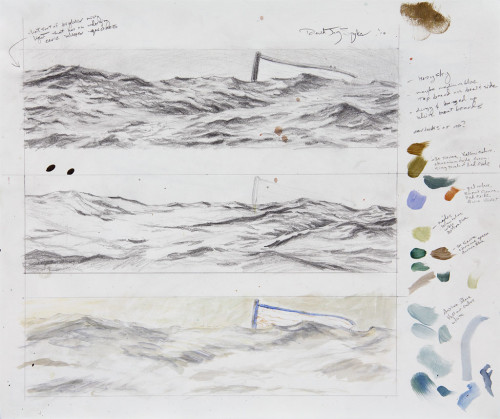
Study for “Cradle”, 2010, graphite, watercolor, and acrylic on paper, 14 x 16.5 in., by David Jay Spyker
When Cradle was at the 2012 competition in St. Joseph, Michigan, a woman who was part of a creative writing group there came up to me and said they each had to choose a piece in the show and write a story based on it. She chose Cradle, and said she imagined there was a man lying in the boat, that he had been there a long time, and whether he was alive or dead was something of a mystery. I felt Cradle conveyed a sense of strange mystery as well, so hearing what she said was encouraging.
Thoughts and especially emotions are something I’m trying to conjure when someone looks at my art, so people’s interpretations of my paintings – learning what kind of thoughts and feelings they have when they engage with it – that’s always interesting.
“Copley to Kentridge: What’s New in the Collection?” is on display 9/14 – 12/1, 2013 at the Kalamazoo Institute of Arts, 314 S. Park St., Kalamazoo, MI 49007.
Distant Light
At barely four inches tall, it’s not a grand landscape on the scale of a Church or a Bierstadt, but it feels so much larger to me. Distant Light looks north along the Lake Michigan shore from a spot above the mouth of the Kalamazoo River. At the farthest point of land lies the lighthouse that guards the entrance to Macatawa Bay in Holland, Michigan. That reference in the title is clear enough; it’s the rest of the story that’s not so obvious.
The season is pushing hard through autumn after all the summer people have abandoned the lakeshore. The days are growing shorter, the weather’s character has changed to match, and the sun is nearing the flat, dark line of the lake’s horizon. The light will soon be lost to another day.
I cherish this time of year.
My wife and I have walked these shores countless times in all seasons – so much time spent and memory earned. Trips to Saugatuck, South Haven, Holland, Grand Haven; the lake is never far from your mind here. My parents used to own a home on the lake not far from that lighthouse. Visits always meant a walk on the beach.
Tricia and I were married on a mist-shrouded June day up that coast, just a twenty-minute walk south of Big Red. It was an amazing gift of a day. It had rained nine inches over night and into that morning, and from the bluff we could only see a six foot strip of water through the rolling fog – sometimes even the shore was hidden. There could not have been a more magical day to marry my best friend at the lake in June; the quiet and peace… I still get chills when I think about it.
This little painting is a distillation of two decades worth of memories and emotions. The distance here is both physical and temporal. The light sits at the tip of the farthest point, it sets over the water and slants in to illuminate a patch of dune, and it shines on in our hearts and minds.
Art Exhibitions: Acrylics Award Competition Crows Exhibition Painting Winter
by David Jay Spyker
leave a comment
“Winter Murder” Wins Award at Michigan Artists Competition
“Winter Murder” won the top Southwest Michigan Watercolor Society Award for water-based media at the Michigan Artist’s Competition in Battle Creek. The Watercolor Society sponsored three awards at this year’s show.
Also in the show is the piece, “Homeward”. See the exhibition at the Art Center of Battle Creek, 265 E. Emmett Street, Battle Creek, Michigan 49017 through June 29, 2013.
Art Artistic Motivations: Acrylics ArtPrize Birds Drawings Drybrush Painting Water Watercolors
by David Jay Spyker
leave a comment
Sudden Flight
I was in South Haven, Michigan, out on the north pier watching jets of water shoot up in the recesses along the steel side as the waves rolled in. This gull had been standing there on the soaked concrete, looking at me instead of the water behind, when it was startled into flight.
I felt this was a great image, and revisited it on and off for months. It started out as a thought about how life is fragile, and tied in with how I’ve been seeing gulls as metaphors for people. Here was this bird with all the world crashing around, and it seemed so small and at the mercy of the greater power of nature – so transitory.
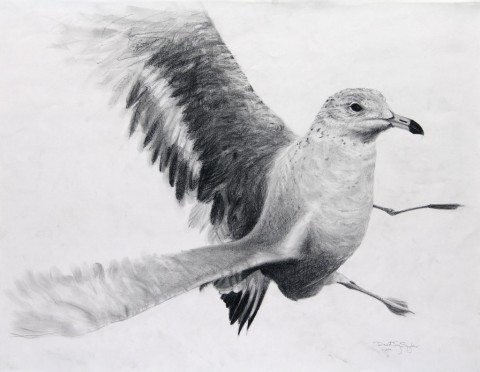
“Startled Gull” (Study for Sudden Flight), 2011
Graphite on Paper, 23 x 29 in., by David Jay Spyker~click to enlarge~
It took some time for the deeper personal connection to percolate up, and motivate me to actually get started on the painting:
When the phone rang the second time, I had a feeling something was wrong. Mom’s in the hospital; she had a massive stroke and might not live more than a day. That’s not something you want to hear.
I was on a plane bound for Florida early the next morning, a sudden flight filled with fears and barely restrained, intense sadness.
In spite of the reality of the situation – knowing that this wasn’t going to end with a miracle – hope would come and go throughout each day as I sat in the hospital room, traveled with family to a second hospital that had neurology specialists, and watched mom hooked up to tubes, machines, and monitors.
When you’re sitting there, and hope is not with you at the moment, a vacant numbness takes its place. These two things trade off, back and forth, and mix in with other powerful emotions to make a thick stew.
She never woke up. Her sudden flight had already happened about a week before she finally passed away.
Losing a parent changes something deep inside of you, way down in your core. The truth of your own mortality is never more clear. If you’re fortunate, you come away with the beginning of a more profound understanding of your own heart, and of the things that give meaning to your life.
The thing about life is we never know how much time we have. There is a glass-like fragility to life, to being out there in it all and experiencing the world through this gift we’ve been given.
Get out there and do something meaningful. Live with purpose. Try to be a better human being, be kinder, be more understanding, and especially be more open. That’s how I want to live.
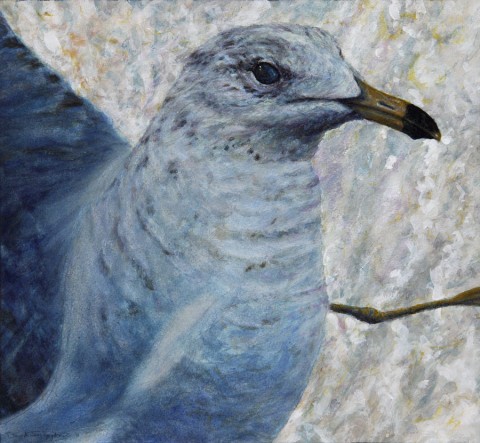
“Startled Gull” (Study for Sudden Flight), 2011
Watercolor and Acrylics on Paper (Lanaquarelle 140 lb. Cold Pressed)
10 5/8 x 11 1/2 in., by David Jay Spyker
~click to enlarge~
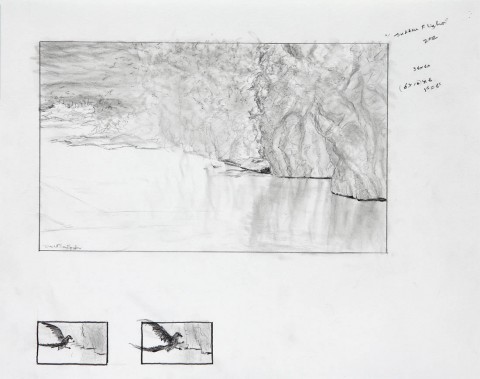
Study for Sudden Flight, 2012, Graphite on Paper (Stonehenge 100% Cotton)
11 x 14 in., by David Jay Spyker
~click to enlarge~
Sudden Flight is displayed in ArtPrize from September 18 – October 6, 2013 at St. Cecilia Music Center, 24 Ransom Ave. NE, Grand Rapids, MI 49503. If you’ll be visiting ArtPrize, please stop by St. Cecilia’s to see the painting.
ArtPrize 2013 Vote Code: 54406
Compass and Piper on Display at Portage District Library
If you are in the Kalamazoo/Portage area, stop by the Portage District Library to enjoy the group show “Birds”. The painting, Compass, and the drawing, Piper, are both part of the exhibition, which runs through May 31st.
Art Artist's Statements Artistic Motivations: Art Philosophy Artist's Statement
by David Jay Spyker
leave a comment
Artist’s Statements, Part 2
You might like to start with Part 1
I recently wrote about my initial reluctance toward having any artist’s statement for my show (Memory, Essence, Mystery). As I thought more and more about it, and began to write, the words also came more easily. I ended up with, in addition to the statement in the catalog, three other statements spaced around the exhibition room. They really helped to tie everything together, and make that personal written connection between the art and the people looking at it.
Each of the three wall cards dealt with an aspect from the show title, though they were not specifically labelled as such:
Memory
There is a relationship to personal experience in my art. What may seem like an “ordinary” landscape or shore scene actually has personal significance to me; it has memory tied to it. Sometimes, there is a reflection of that in the title of a painting. You may not know the exact connection at a glance, but it’s there.
When we interact with people, or engage with places, they become more important to us. We are woven into their fabric, and they into ours. It’s not the place that is significant, it’s what we did or felt while we were there. Each of us also has those special possessions, which mean a lot to us because of the memories surrounding them.
Personal memories and experiences are frequently expressed in my work. I’m trying to talk about them, and my thoughts and feelings that encompass them; I’m just using a visual language to do it.
Essence
There can be a lot of artistic editing that happens when I’m working out a painting based on life. I may alter colors and tones, modify some forms, or even leave out or add certain elements.
For me, there is more leeway when dealing with a landscape than, say, a portrait of a person or a bird – there you want to get the depiction of form and the inner character right.
Getting every branch on a distant tree to match what I see in the landscape isn’t so important, but finding the character of the landscape is. I may change the lighting in a scene so it works toward the emotion of the whole picture.
What matters most is that the picture express how I feel about the subject. I want the deeper character, or essence of it to come through; you should really feel something when you look at it.
Of course, some pieces are complete fabrications, and then any “rules” really fly out the window. It becomes about imagination and creating something that has the emotion I’m after, and says what I want to say.
Mystery
Like Andrew Wyeth’s quietly disturbing, highly personal images or the silent, still moment of a Vermeer, I want to capture a feeling of strange wonder that there may be something deeper and mysterious going on in a painting.
Even when it seems ordinary at first glance, I am so often trying to find something subtle – the lingering of something left unspoken or a kind of breathlessness – a stillness.
Whatever it is, if I can find that deeper emotion and work it into the picture, then I know I’ve done something right. I’m on the right track.
Art Artistic Motivations: Art Philosophy Artist's Statement
by David Jay Spyker
leave a comment
Artist’s Statements, Part 1
Let’s start by saying that as I have matured over the years, I have also become less of a fan of artist’s statements – you know, those paragraphs you see in a show catalog or hanging in the exhibition that explain who the artist is, why they do what they do, and what their work means.
Too often they read like pseudo-sophisticated bullshit that’s tailored to self-stroke the artist’s own ego, to display an intelligence and mastery of the complexities of language, or are designed to appeal to some sort of elite art world ideal.
As I considered what to say about my own most recent show (Memory, Essence, Mystery), I went through a range of emotions on the subject. I considered not even having a written statement in favor of letting the paintings and drawings simply speak for themselves, but eventually decided against it because it was still important to make that connection with the viewer about the work.
When I create art, it’s like writing in a visual language; not everyone thinks that way – a great many people think in words, and there is a communication gap there. Coming up with something to say about my work – to bridge that gap and forge a stronger connection – became important again.
It was also important to speak from the heart because that is the origin of my art; I didn’t want to intellectualize it, and risk losing that chance to speak about my work in a way that would click with people on an emotional level.
The best course for me was to write more like I might speak, to honestly transcribe the words I could hear in my mind without dressing them up in fancy clothing. This is what ended up being printed in the show catalog:
My paintings always have some kind of personal story or significance. There has to be that connection, whether it’s something coming from deep within, an inspiration tied to someone in my life, or memorable experiences that have shaped the way I feel and think about the world around me. Most often it’s all of those things. I feel very fortunate in that regard – to be able to weave those threads together in my art, and have that sort of personal connection on all those levels, because putting that down in a visible, tangible form is how I talk about life. In the end, it’s about personality, what’s in your heart, what you love – you know, that’s what makes your art great, that’s what gives it feeling. Without all of that coming through, what’s the point?
Work from the heart – write from the heart.
Memory, Essence, Mystery opens August 19
Featuring 23 works by David Jay Spyker, the solo show titled Memory, Essence, Mystery opens Sunday, August 19 at the Carnegie Center for the Arts in Three Rivers, Michigan. There will be a reception from 2-4 pm. The exhibition runs through October 14.
Carnegie Center for the Arts
107 N. Main St.
Three Rivers, MI 49093
